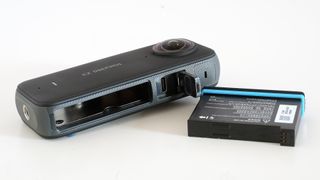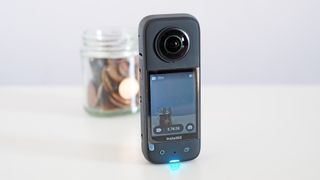Early Verdict
Insta360 has taken the do-it-all 360-degree camera approach of the old One X2 and jazzed it up with a much larger display and slightly bigger camera sensors. Some of the more obvious omissions have been filled in too, such as 4K capture when treating it like a single lens action cam. The Insta360 X3 is an improved take on one of the best all-round action cameras.
Pros
- +
Can be used as a 360-degree or single lens camera
- +
Active HDR is useful for avoiding blown highlights
- +
Larger screen improves menu navigation significantly
Cons
- -
Some pre-launch software issues
- -
Slightly more expensive than the old model
Why you can trust TechRadar
The Insta360 X3 is a candybar-shaped 360-degree camera, with a silhouette closer to that of a classic feature phone than a GoPro. It’s the follow-up to the Insta360 One X2 from 2020, and its aims are pretty similar.
It’s a do-everything action camera. Less terrifying than the pricey Insta360 One RS 360 1-inch Edition, and it feels more at home in your hand than the standard-setter GoPro Max.
You’ll pay $449 for one of an Insta360 X3. It’s marginally cheaper than the GoPro Max, $20 more than the original cost of the Insta360 One X2. That camera arrived in 2020, and given how the world’s economy has been further hit since then, maybe we should be glad it hasn’t gone up further.
Ahead of our full review, here’s our quick take on a few of good and bad bits of the Insta360 X3.

First impressions
Breezy fun seems to be Insta360’s main goal with the X3. It is not a camera that, like a GoPro, shies away from bare handheld use.
It’s a palm-friendly stick with a front shutter button that is within easy thumb reach as soon as you pick the thing up. The casing gets warm after a few minutes, but that’s unavoidable as the battery sits right under your fingers. And have you tried shooting a 4K video for 10 minutes with your phone recently?
Much of the fundamentals are the same as last time around. The Insta360 X3 has good 10m water resistance, but if you want to take it diving you should get Insta360’s upcoming underwater case. It uses a proprietary battery that slots into the side like an ammo clip from an action movie.
The big change for this generation is the screen. This 2.6-inch LCD is much bigger than that of any Insta360 camera of this level to date.
It makes navigating through the UI a relative breeze. And while the software layout style hasn’t changed much, it just looks a bit more polished and glossy when rendered with more pixels.
The view you get is a portrait window. It might remind you of the vlog-style videos you see on TikTok and Instagram. That might be off-putting if you tend to think in 16:9 landscape terms when shooting videos.
But in effect, it doesn’t matter all that much. This is a 360 degree camera, with ultra-wide angle lenses on each side. While you might want to center your subject to get the best possible sharpness, any other scene composition can be done in the edit.

Hardware and video quality
The two cameras inside the Insta360 X3 use 1/2-inch sensors. They’re a little larger than those of the GoPro Hero 10 Black, GoPro Max and Insta360 One X2.
However, you’re not going to get the sort of obvious image quality improvement the 1-inch sensor of the Insta360 One RS 1-inch Edition provides.
After walking around streets and parks with the Insta360 X3, it’s clear a lot of the classic Insta360 action camera character remains. There’s a greater focus on detail retention than in a GoPro, but that means fine texture detail can seem to fizz as the camera moves.
On sunny days you’ll see some blown highlights in bright clouds. And night image quality is pretty poor — the action camera norm.
However, the Insta360 X3 does have some tools to make the situation much better. The Active HDR mode works wonders for avoiding blown highlights and retaining realistic color in sunny skies when there are other darker elements in view that cause the camera to up the exposure.
This works by capturing two images for each frame, which leads to a maximum frame rate of 30fps. But it really does help with those blown highlights that can’t be restored in the edit.
For low-light shooting you have the Starlapse mode. This promises to radically improve low-light quality, just as we saw in Insta 360’s 1-inch sensor 360 RS. However, we had some problems getting it to play nice with the Insta360 editing app so we’ll have to save our conclusions for the full review.
As often happens with fresh Insta360 launches, we have encountered a few Insta360 X3 bugs, but they are mostly to do with the interplay been the app and camera. Actually using the camera itself has been smooth and stress-free.
This helped to bolster our initial impression of the Insta360 X3 as a fun, easy-going camera that can do an awful lot but isn’t intimidatingly large.
Having come from reviewing some of the company’s larger models, we also love the “single lens” modes. These let you treat the Insta360 X3 like a regular, non-360-degree camera. No editing required; you can just pull the clips straight off the camera to a laptop over USB.
The Insta360 One X2 has these too, of course, but the Insta360 X3 can now capture flat 16:9 footage at 4K resolution. You’re limited to 30fps, although a minor drop down to 3.6K resolution unlocks 60fps.
Is it the only action camera you’ll need? Quite possibly, and it can pull stunts that are impossible with a Hero 10 Black, a camera that was more expensive — at launch — without GoPro’s subscription tied in.
We’ll be back with our verdict on the Insta360 X3 soon in our full review.
Andrew is a freelance journalist and has been writing and editing for some of the UK's top tech and lifestyle publications including TrustedReviews, Stuff, T3, TechRadar, Lifehacker and others.
What is a hands on review?
Hands on reviews' are a journalist's first impressions of a piece of kit based on spending some time with it. It may be just a few moments, or a few hours. The important thing is we have been able to play with it ourselves and can give you some sense of what it's like to use, even if it's only an embryonic view. For more information, see TechRadar's Reviews Guarantee.

How to watch Apple's May 2024 iPad launch event

'Inspired by the human brain': Intel debuts neuromorphic system that aims to mimic grey matter with a clear aim — making the machine exponentially faster and much more power efficient, just like us

Quordle today – hints and answers for Sunday, April 28 (game #825)

